
William Cuthbert Faulkner was an American writer known for his novels and short stories set in the fictional Yoknapatawpha County, based on Lafayette County, Mississippi, where Faulkner spent most of his life. A Nobel laureate, Faulkner is one of the most celebrated writers of American literature and often is considered the greatest writer of Southern literature.

Absalom, Absalom! is a novel by the American author William Faulkner, first published in 1936. Taking place before, during, and after the American Civil War, it is a story about three families of the American South, with a focus on the life of Thomas Sutpen.

The Sound and the Fury is a novel by the American author William Faulkner. It employs several narrative styles, including stream of consciousness. Published in 1929, The Sound and the Fury was Faulkner's fourth novel, and was not immediately successful. In 1931, however, when Faulkner's sixth novel, Sanctuary, was published—a sensationalist story, which Faulkner later said was written only for money—The Sound and the Fury also became commercially successful, and Faulkner began to receive critical attention.
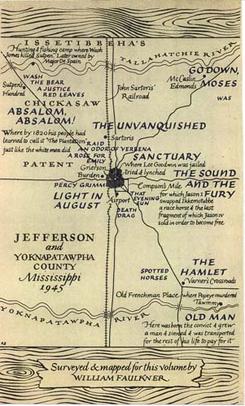
Yoknapatawpha County is a fictional Mississippi county created by the American author William Faulkner, largely based upon and inspired by Lafayette County, Mississippi, and its county seat of Oxford. Faulkner often referred to Yoknapatawpha County as "my apocryphal county".
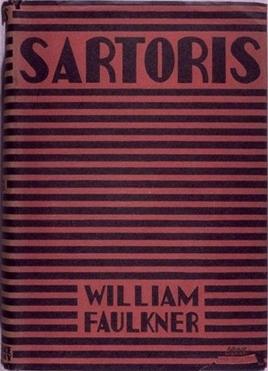
Sartoris is a novel, first published in 1929, by the American author William Faulkner. It portrays the decay of the Mississippi aristocracy following the social upheaval of the American Civil War. The 1929 edition is an abridged version of Faulkner's original work. The full text was published in 1973 as Flags in the Dust. Faulkner's great-grandfather William Clark Falkner, himself a colonel in the American Civil War, served as the model for Colonel John Sartoris. Faulkner also fashioned other characters in the book on local people from his hometown Oxford. His friend Ben Wasson was the model for Horace Benbow, while Faulkner's brother Murry served as the antetype for young Bayard Sartoris.
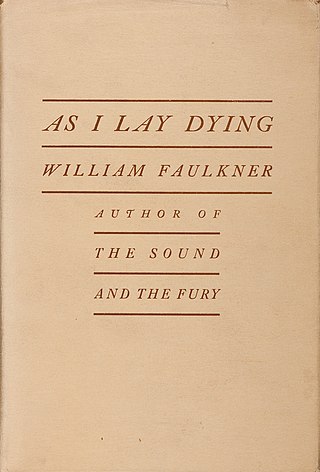
As I Lay Dying is a 1930 Southern Gothic novel by American author William Faulkner. Faulkner's fifth novel, it is consistently ranked among the best novels of 20th-century literature. The title is derived from William Marris's 1925 translation of Homer's Odyssey, referencing the similar themes of both works.
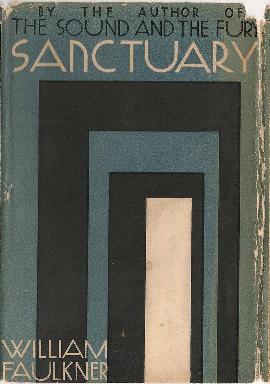
Sanctuary is a 1931 novel by American author William Faulkner about the rape and abduction of an upper-class Mississippi college girl, Temple Drake, during the Prohibition era. The novel was Faulkner's commercial and critical breakthrough and established his literary reputation, but was controversial given its themes. It is said Faulkner claimed it was a "potboiler", written purely for profit, but this has been debated by scholars and Faulkner's own friends.

Go Down, Moses is a 1942 collection of seven related pieces of short fiction by American author William Faulkner, sometimes considered a novel. The most prominent character and unifying voice is that of Isaac McCaslin, "Uncle Ike", who will live to be an old man; "uncle to half a county and father to no one". Though originally published as a short story collection, Faulkner considered the book to be a novel in the same way The Unvanquished is considered a novel. Because of this, most editions no longer print "and other stories" in the title.

Intruder in the Dust is a 1948 crime novel written by American author William Faulkner. Taking place in Mississippi, it revolves around an African American farmer accused of murdering a Caucasian man.

The Reivers: A Reminiscence, published in 1962, is the last novel by the American author William Faulkner. The bestselling novel was awarded the Pulitzer Prize for Fiction in 1963. Faulkner previously won this award for his book A Fable, making him one of only four authors to be awarded it more than once. Unlike many of his earlier works, it is a straightforward narration and eschews the complicated literary techniques of his more well-known works. It is a picaresque novel, and as such may seem uncharacteristically lighthearted given its subject matter. For these reasons, The Reivers is often ignored by Faulkner scholars or dismissed as a lesser work. He previously had referred to writing a "Golden Book of Yoknapatawpha County" with which he would finish his literary career. It is likely that The Reivers was meant to be this "Golden Book". The Reivers was adapted into a film of the same name directed by Mark Rydell and starring Steve McQueen as Boon Hogganbeck.

The Hamlet is a novel by the American author William Faulkner, published in 1940, about the fictional Snopes family of Mississippi. Originally a standalone novel, it was later followed by The Town (1957) and The Mansion (1959), forming the Snopes trilogy.

The Mansion is a novel by the American author William Faulkner, published in 1959. It is the last in a trilogy of books about the fictional Snopes family of Mississippi, following The Hamlet and The Town.

Requiem for a Nun is a work of fiction written by William Faulkner. It is a sequel to Faulkner's early novel Sanctuary, which introduced the characters of Temple Drake, her friend Gowan Stevens, and Gowan's uncle Gavin Stevens. The events in Requiem are set in Faulkner's fictional Yoknapatawpha County and Jackson, Mississippi, in November 1937 and March 1938, eight years after the events of Sanctuary. In Requiem, Temple, now married with a child, must learn to deal with her violent, turbulent past as related in Sanctuary.

The Unvanquished is a 1938 novel by the American author William Faulkner, set in the fictional Yoknapatawpha County. It tells the story of the Sartoris family, who first appeared in the novel Sartoris. The Unvanquished takes place before that story, and is set during the American Civil War. Principal characters are Bayard Sartoris, John Sartoris, Granny, Ringo (Morengo), Ab Snopes, Cousin Drusilla, Aunt Jenny, Louvinia, and the lieutenant.
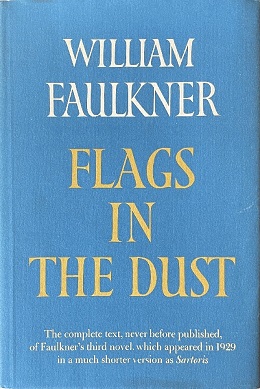
Flags in the Dust is a novel by the American author William Faulkner, completed in 1927. His publisher heavily edited the manuscript with Faulkner's reluctant consent, removing about 40,000 words in the process. That version was published as Sartoris in 1929. Faulkner's original manuscript of Flags in the Dust was published in 1973, and Sartoris was subsequently taken out of print.

Mosquitoes is a satiric novel by the American author William Faulkner. The book was first published in 1927 by the New York-based publishing house Boni & Liveright and is the author's second novel. Sources conflict regarding whether Faulkner wrote Mosquitoes during his time living in Paris, beginning in 1925 or in Pascagoula, Mississippi in the summer of 1926. It is, however, widely agreed upon that not only its setting, but also its content clearly reference Faulkner's personal involvement in the New Orleans creative community where he spent time before moving to France.
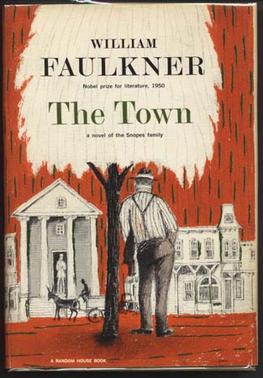
The Town is a novel by the American author William Faulkner, published in 1957, about the fictional Snopes family of Mississippi. It is the second of the "Snopes" trilogy, following The Hamlet (1940) and completed by The Mansion (1959).

Edward McKnight Kauffer was an American artist and graphic designer who lived for much of his life in the United Kingdom. He worked mainly in poster art, but was also active as a painter, book illustrator and theatre designer.
Knight’s Gambit is a 1949 short story collection by American author William Faulkner. Including the titular story, the book collects six of Faulkner’s stories about attorney Gavin Stevens, who also takes a leading part in his novel Intruder in the Dust (1948).
Gavin Stevens is a lawyer and the county attorney in Jefferson in Faulkner's fictional Yoknapatawpha County, Mississippi. He was educated at Harvard and Heidelberg universities.





















